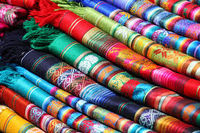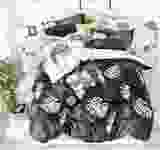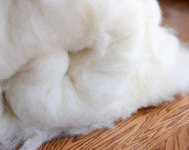How to choose quality bed linen- a guide to textile materials

Good quality bedspreads and doona or quilts, are made with a number of high qaulity fibres. They mainly includes percale, sateen, Egyptian cotton, silk, matelasse, cotton chintz, chenille, or even velvet as these fabrics tend to have a tight weave and thick threads that increase the durability and opulence of the cover.
Australians are increasingly favouring pure cotton, says Myer Bedlinen Category Buyer, Rebecca Fanelli, but that is not to suggest that poly-cotton sheets don't have their place. If you're looking for easy care and affordability, a blend could be the way to go, she says. Synthetic fabric sheets is also used in some lower-end products today. Although synthetic fibres like modal, lyocell and polyester have strength and durability, they aren't as breatheable compared to cotton and poly blend fabrics.
- Sateen
Sateen, not to be confused with the material satin, is a type of weave, with a satin-like finish, often found in bed sheets. Sateen is usually applied to cotton, or sometimes rayon. Better qualities are mercerized to give a higher sheen. Some are only calendered to produce the sheen but this disappears with washing and is not considered genuine sateen. Sateen may be bleached, dyed, or printed. It is difficult to make good bound buttonholes on it as it has a tendency to slip at the seams.
Sateen produces the sheen and softer feel through the use of a different structure in the weaving process. The sateen structure is four over, one under, placing the most threads on the surface, making it extremely soft, though slightly less durable than other weaves. Standard, non-sateen, weaves use a one over, one under structure. Satin also uses this structure, however, instead of using cotton, different materials are used (e.g., silk, polyester, etc)
- Egyptian Cotton
The term Egyptian cotton is usually applied to the extra long staple cotton produced in Egypt and used by luxury and upmarket brands worldwide. Egyptian cotton is the native American species Gossypium barbadense which was introduced by Mohammad Ali Pasha in the 19th century. During the cotton famine caused by the American Civil War, Egyptian-grown cotton was promoted and received much investment, becoming a preferred alternate source for British textile mills. Indian surat cotton could only be used for coarse counts and would not spin on the existing machinery. Most of what is labeled Egyptian cotton today, however, also includes long staple cotton, the product of the other native American species Gossypium hirsutum. The ancient Egyptians made their clothing from linen, a product of the flax plant.
- Percale
The term describes the weave of the fabric, not its content, so percale can be a 50/50 blend of cotton and polyester, 100% cotton, or a blend of other fabrics in any ratio. A percale weave has a thread count of about 200 or higher, and is noticeably tighter than the standard type of weave used for bed-sheets. It has medium weight, is firm and smooth with no gloss, and warps and washes very well. It is made from both carded and combed yarns. Percale fabrics are made in both solid colors and printed patterns. The finish of the fabric is independent of its weave, so it can be either printed or unprinted. Percale was originally imported from India in the seventeenth and eighteenth centuries, then manufactured in France. The word may originate from the Persian 'rag', although the Oxford English Dictionary (Dec. 2005) has traced it only as far as 18th-century French.
- Organic Cotton
Organic cotton is not specific type of cotton. It refers to a group of cotton products that are made from non genetically modified plants. They grow without the application of any synthetic agricultural chemicals such as fertilizers or pesticides. The organic production additionally promotes and enhances biodiversity and biological cycles on the earth. Cotton growers who make the transition to biologically based growing practices expect to not only offer a healthier and cleaner product, but to also benefit the planet in many fields, such as protection of surface and groundwater quality,reduction of risk insect and disease control and yield soils with better organic matter content.








